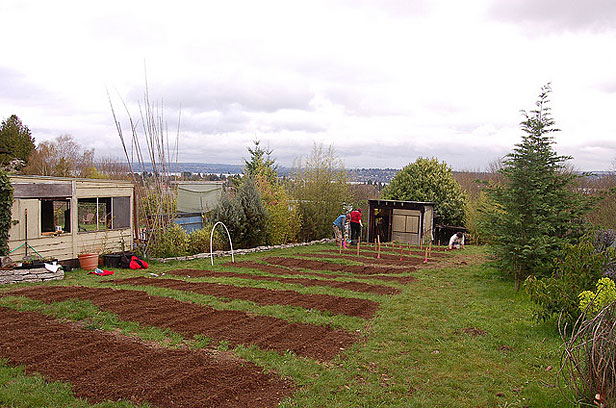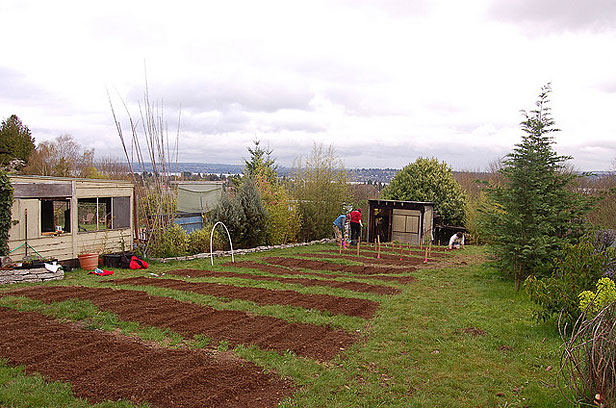 Alleycat Acres breaks ground on one of its donated lots.Photo courtesy e_pants via Flickr
Alleycat Acres breaks ground on one of its donated lots.Photo courtesy e_pants via Flickr
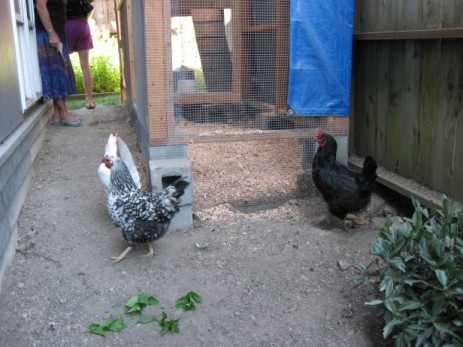 To roost or roast: Chickens at the Esbhani residence in Seattle.Photo: Tyler FalkAsif and Adila Esbhani let four chickens out of their coop and watch them search for bugs down the long, narrow dirt path next to the couple’s Seattle home.
To roost or roast: Chickens at the Esbhani residence in Seattle.Photo: Tyler FalkAsif and Adila Esbhani let four chickens out of their coop and watch them search for bugs down the long, narrow dirt path next to the couple’s Seattle home.
The sleek new structure represents no small feat for the Esbhanis. “We never owned a saw until we decided to build the coop. It was our first trip to the lumber store,” Adila told me on a chicken coop tour hosted recently by Seattle Tilth, a sustainable gardening education organization.
“We’ve never been on a farm. We’ve always lived in cities and we didn’t think we’d be able to [raise chickens],” Adila said. “Having fresh eggs is just amazing,” her husband added.
Down the street, Kent Brookover and his wife, Karen Lewis, showed visitors around their untamed yard, where tall grasses and flowers mingle with asparagus stalks, raised beds, a beehive, and chickens nibbling small patches of lawn grass under a large shade tree. The couple has raised chickens for four years. But unlike the Esbhanis, Brookover grew up on a farm in Kansas and worried the birds’ noise and smell would be too much. That hasn’t been the case, he was pleased to report.
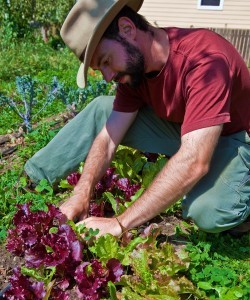 Lettuce plant, please! Josh Parkinson tends to his backyard farm in West Seattle.Photo: Magic Bean FarmOver in West Seattle, Josh Parkinson tends Magic Bean Farm, which he and his significant other, Shabnam Basmani, started earlier this year — in someone else’s backyard.
Lettuce plant, please! Josh Parkinson tends to his backyard farm in West Seattle.Photo: Magic Bean FarmOver in West Seattle, Josh Parkinson tends Magic Bean Farm, which he and his significant other, Shabnam Basmani, started earlier this year — in someone else’s backyard.
That’s the irony underlying Seattle’s urban agriculture scene: the city is one of the friendliest to chicken fanciers and backyard farmers, but bottle-necked as it is by water, Seattle can be no breadbasket. Unlike in cities such as Detroit, vacant land is expensive and scarce; what there is gets quickly snatched up for parks and open spaces.
But Parkinson is resourceful. He connects with people who have empty land using Urban Garden Share — a website started in Seattle that hooks up gardeners with unused yards or vacant lots. Through the site and word of mouth, the farm is spreading quickly, and more and more vacant lawn space is coming his way. Magic Bean Farm currently works on 10 spots totaling about a half-acre.
From this tiny network, Parkinson is feeding members for the farm’s Community Supported Agriculture program — people who pay in advance for a share of the harvest — along with the owners of the land he farms.
Now that’s magic.
Fertilizing the city farm
Technically, however, Parkinson has been working in a gray area this year. Until yesterday, it was illegal to run a commercial farm from private, non-agriculturally designated property.
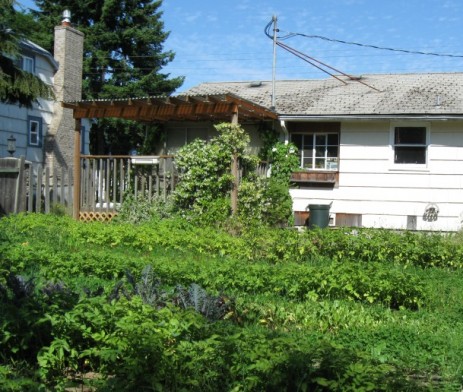 Jolly giant greenness: The Magic Bean backyard farm is technically illegal, but Seattle code is about to change.Photo: Darby Minow SmithBut Seattle has been quickly working to improve the urban farming landscape in the city. This year was declared the “year of urban agriculture” by new Mayor Mike McGinn. And on August 16, the Seattle City Council approved new legislation that allows urban farmers (meaning anyone) to grow and sell food in all zones and on private property. Also, to please the more garden-variety backyard farmers, the city is increasing the number of allowed domestic fowl from three to eight — a much requested change.
Jolly giant greenness: The Magic Bean backyard farm is technically illegal, but Seattle code is about to change.Photo: Darby Minow SmithBut Seattle has been quickly working to improve the urban farming landscape in the city. This year was declared the “year of urban agriculture” by new Mayor Mike McGinn. And on August 16, the Seattle City Council approved new legislation that allows urban farmers (meaning anyone) to grow and sell food in all zones and on private property. Also, to please the more garden-variety backyard farmers, the city is increasing the number of allowed domestic fowl from three to eight — a much requested change.
“We found that [the code] was silent like many major cities. It’s just, we don’t address urban agriculture,” said Andrea Petzel, a senior urban planner with Seattle’s Department of Planning and Development who headed up the policy changes. “The whole point of zoning was to separate these kinds of uses particularly agriculture and industrial away from where people lived. And now the trend is, with places like Magic Bean Farm and Alleycat Acres, to bring agriculture into the city more. It’s completely rethinking the way cities use land.”
But as the city has been working to pass these initiatives, a groundswell of people, organizations, and businesses haven’t been waiting for official support, they’re plowing along just fine. In fact, they have been for decades.
Deep roots in urban ag
Unsurprisingly for a city that boasts an early 20th-century farmers market as one of its most popular tourist attractions, there are organizations in Seattle that have been promoting local urban food for years.
Seattle seeded its first P-Patch community garden — plots of land divided up into individual plots for gardening — in 1973, during the height of back-to-the-land fervor. The U.S. was in the middle of an energy crisis, and Boeing, the largest company in Seattle at the time, cut more than half of its 80,000 employees, leaving Seattle in a deep recession. (One famous sign announced, “Would the last person leaving Seattle … turn out the lights?”) The economic downturn combined with the social activism scene of the ’70s to jump-start programs and organizations that are still active and thriving. Today there are 73 P-Patch community gardens in Seattle, comprising more than 23 acres of the city’s precious land and feeding more than 2,000 households. (See P-Patch spotlight, below.)
A few years later, in 1978, Seattle Tilth broke through a concrete play area to construct its first garden to educate people about growing their own produce. Today, there are three community learning gardens in the city, open to the public, that demonstrate year-round vegetable gardening, soil building techniques, and composting, among other things.
And starting in 1988, the nonprofit Solid Ground has worked to provide low-income residents with access to fresh organic produce, seeds, and gardening information through its Lettuce Link program. The group encourages community gardeners to plant an extra row of organic produce to donate to food banks and other meals programs. In 2009, over 27,000 pounds of produce was donated by P-Patch community gardens across the city.
Starting from scratch
A fresh crop of creative and innovative urban-ag projects are sprouting up in the Emerald City. Earlier this year, Sean Conroe gathered up like-minded Seattleites interested in urban farming and sta
rted the nonprofit Alleycat Acres. The urban farming collective works with volunteers to turn empty donated private land into urban farms, and the produce is biked to local food banks. (Learn more in the Alleycat spotlight, next page.)
City Fruit makes sure the abundance of fruit on Seattle’s trees doesn’t go to waste. Using Google Maps, it shows where 650 fruit trees are located. Though many of the trees are on private land, you can find some trees where the fruit is up for grabs. And the group helps fruit tree owners harvest and find use for their excess. In its first year, the group harvested more than 5 tons of fruit from 100-plus households.
This year, Harvest Collective is working on an online marketplace for backyard farmers in Seattle to sell their produce. And a new landscaping company, Cascadian Edible Landscapes, is working to develop underutilized land into places that can produce food for individuals, businesses, and governments. Cascadian uses a sliding scale for fees, to make sure their services are available to broader populations.
The city is doing its best to keep up with this groundswell of people, organizations, and businesses growing food in the city while making money, feeding those in need, and finding uses for vacant, but valuable land.
“Detroit’s kind of famous right now for urban ag stuff, but they don’t have the city codes to match up with that. And that’s mostly what’s happening with other cities,” said Petzel. “Seattle is one of the first cities to really look at their codes to try to match up with what the pressure is from the community.”
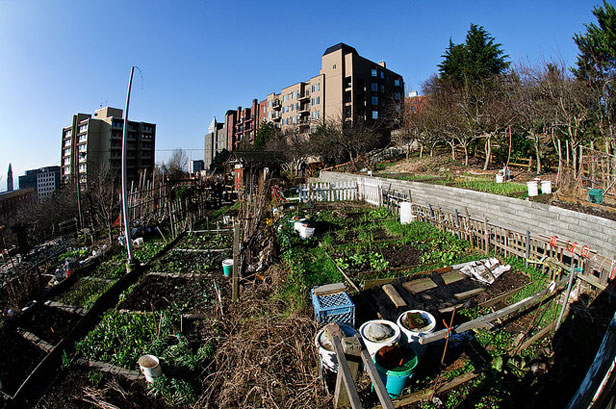 Mind your Ps and queues: A P-Patch community garden in Seattle’s International District. Many of the patches have long waiting lists for plots.Photo courtesy slightlynorth via Flickr
Mind your Ps and queues: A P-Patch community garden in Seattle’s International District. Many of the patches have long waiting lists for plots.Photo courtesy slightlynorth via Flickr
P-Patch Community Gardens
Headquartered at Seattle Municipal Tower, with 73 gardens around the city
What: A city government program that assists communities in acquiring land for community gardens and helps in managing them.
Roots of the project: The first P-Patch garden grew out of a social climate not unlike today. Local economic upheaval, booming social activism, and the countrywide “back-to-the-land movement” were all flourishing at the start of the ‘70s in Seattle.
These factors motivated a local college student to start a community garden on land belonging to a family called Picardo (P-Patch’s namesake). The student, Darlyn Runberg Del Boca, persuaded the City of Seattle to lease the lot for the price of its property taxes.
By the end of the ‘70s, 10 other P-Patches were growing around Seattle, according to the organization’s extensive history of the program.
Forty years later, through varying degrees of community interest and support — in 1983, a Seattle Times headline asked, “Has the P-Patch Program Gone Fallow?” — the program is stronger than ever. The city has plans to add two to three new patches a year. Some gardens have years-long waiting lists for plots.
Nowadays, P-Patch works with a neighborhood community to find a vacant piece of land — whether a privately owned overgrown lot, or government land set aside for road right-of-ways. The program helps the community attain permission for a garden and lobbies on its behalf. This wins community’s land away from less desirable uses, such as drug dealers hiding in the blackberries to Blackberry -wielding golfers.
The harvest: P-Patch Community Garden Coordinator Julie Bryan is fond of the phrase “By the people, for the people.” And in a rare win for government, it seems to ring true for a municipal program.
Often other nonprofit or government programs spring up alongside patches. Some gardens have low-income housing built around them. At three of the gardens, gardeners are allowed to sell produce to supplement their income and to share the garden with the rest of the community.
Bryan drove me around to a few patches in her cluttered station wagon with a tie-dyed car-key cover. I asked that hardened bureaucrat — she’s been with P-Patch 15 years — what her favorite part of the job was. She smiled and said, “You’re about to meet them.”
Although P-Patch prefers plots that are rectangular, the patches themselves are as varied and unique as the Seattle neighborhoods themselves. The program keeps statistics on the diversity of each neighborhood and aims to have it reflected in the gardeners.
Bryan can guess the ethnic makeup of the neighborhood just by taking a look in the vegetable beds. At the first garden we stop at, the High Point Market Garden in West Seattle, the gardeners are primarily a mix of Thai, Cambodian, Laotian, and Vietnamese immigrants — countries that often have border disputes. Here, “they talk, they share recipes, they find out they have a lot in common,” Julie says. And they garden side by side.
 Lots of food: Alleycat Acres volunteers harvesting from one of the group’s donated sites. Photo courtesy e_pants via Flickr
Lots of food: Alleycat Acres volunteers harvesting from one of the group’s donated sites. Photo courtesy e_pants via Flickr
By Tyler Falk
Alleycat Acres
Beacon Hill and Central District neighborhoods
What: A nonprofit urban farming collective.
Roots of the project: In late 2009, Sean Conroe sent an email to people interested in urban agriculture to see if they’d be interested in starting an urban farming collective. In January, a group met to discuss how they wanted to run an urban farm. Only a week after their first meeting, a landowner in the Beacon Hill neighborhood donated a vacant lot — and Alleycat Acres was born. “It was a bunch of strangers. None of us had really met before,” says Gia Clark, one of seven lead Alleycats. “It was all Internet-based.”
Harvest: Seven volunteers started farming on vacant lots in Seattle’s Beacon Hill and Central District neighborhoods. But instead of dividing the land into plots for individuals to tend, the group works with volunteers from the community to do the work in exchange for some of the produce that is harvested.
“It’s a work-share. If you’re a volunteer, you get to have food, and what we don’t give to the volunteers that come work, we either hand out to people who walk by or we deliver to the Beacon Avenue Food Bank,” says Clark.
So far, volunteers for Alleycat Acres
have logged more than 1,500 hours and donated 400 pounds of produce. And because the focus is on feeding the community, you don’t have people planting the same produce right next to each other, as they do in “community gardens” tended by individual families. “Instead of it being individually based and having the essence of private property, what we’re looking at is more of a collective use of land. In order to get that high-yield farm production, everyone is contributing to every square inch,” Clark explains. And so you are actually able to grow everything together.”
Alleycat Acres is just in its first year, but it hopes to grow by transplanting its model to other neighborhoods, starting up more community gardens that are sustained by the neighborhood.
“We want community members to be farm managers — the people who’re coordinating the water, the work parties, the maintenance, and the deliveries. We essentially create a framework and give assistance when people need help,” Clark said.
There are obviously difficulties with the model. Finding vacant lots that can be used for urban farms is a challenge. Property values are high, unlike in many cities where urban agriculture is thriving. Still, Alleycat Acres provides an important model combining education, food security, and community spirit.
“We’re not proposing that we can feed the city of Seattle only through the venture,” Clark explains. “We’re saying is that this is a really important supplement to a food system that isn’t working.”
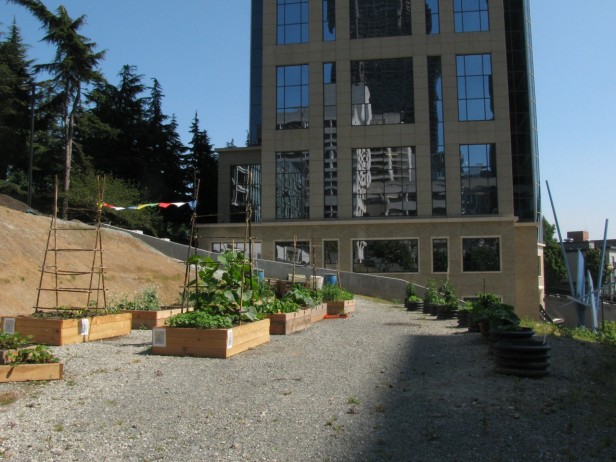 Free beds: Goat Hill Giving Garden in downtown Seattle donates its harvest to food banks and the nearby transient population.Photo: Stephanie Joyce
Free beds: Goat Hill Giving Garden in downtown Seattle donates its harvest to food banks and the nearby transient population.Photo: Stephanie Joyce
By Tyler Falk
Goat Hill Giving Garden
Downtown Seattle
What: A garden started in a vacant lot in downtown Seattle by King County employees.
Roots of the project: In 2009, King County employees came up with the idea to start a garden in a vacant lot across from their building. In June 2010, the garden, made with materials that were all scavenged or donated, was dedicated by King County Executive Dow Constantine.
Harvest: A grassroots garden is growing quickly in a sunny clearing of what was supposed to be a jail. While the fate of the land is in limbo, King County employees have put it to good use.
“Our reasons for creating the Goat Hill Giving Garden are to show [King County] employees how to eat smart and do this in their own yards,” says Caroline Hughes, a King County employee and one of the garden organizers. “It gives them a chance to move more, and stress less during their lunch break.”
The garden, which consists of six raised beds and 10 round planters, is maintained by county employees on a purely volunteer basis.
The garden is used as an education tool to teach county employees how to grow a lot in a limited space. Anyone can walk right up and see how the garden works, and expert volunteers offer classes on basic gardening topics. The garden is used by the county wastewater treatment to demonstrate the advantages of using their biosolid compost, GroCo.
County employees aren’t the only benefactors of the garden. All of the produce — so far 39 pounds, mostly lettuce — has been donated to Pike Market Senior Center & Downtown Food Bank.
A large transient population lives around the lot. They aren’t fenced out. “We know we’re planting something that isn’t normally here and that if people wander through the area and see something that looks good, they might take it,” said Hughes. “We’re not a P-Patch. We aren’t employees who are looking to take this stuff home. We’re donating it to a food bank and senior center anyway, so if some of that transient population does some pre-harvesting … well, they’ve just saved us a little bit of time.”
Unfortunately, this project can’t grow on forever — Hughes thinks they will have the garden for 5 to 10 years, “though we do have an understanding that if they need it for something that’s business related, of course we’re right out of there,” she said.

